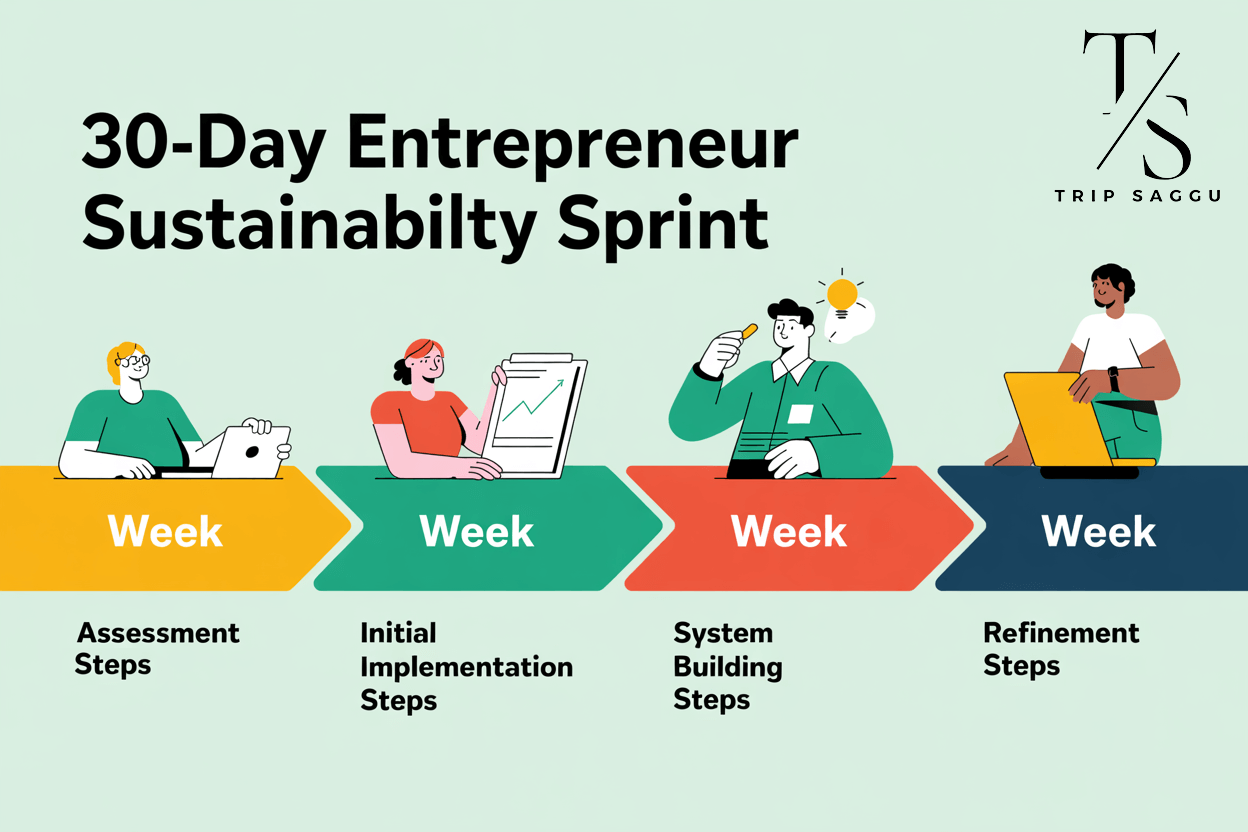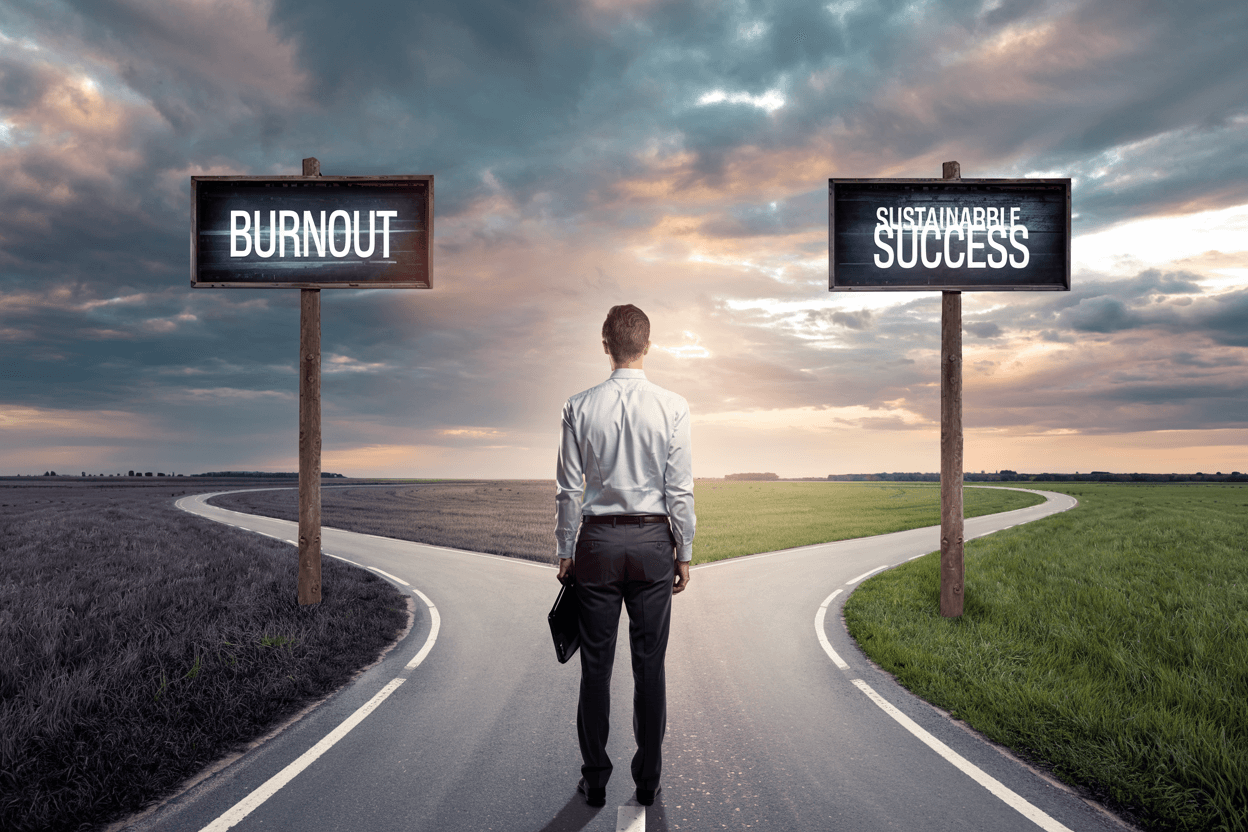The email chimes at 11:30 PM. You promise yourself it’s the last one you’ll check tonight—exactly what you promised yesterday. Your shoulders ache, your mind races, and that holiday you’ve been planning keeps getting postponed. Sound familiar?

Let me explain why this matters. I was sitting across from a successful tech founder recently when he confessed, “Trip, I’ve built a business that’s making millions, but I haven’t seen my kids awake in two weeks. Something’s broken, and I think it’s me.”
I’m Trip Saggu, and after two decades as an entrepreneur and business coach, I’ve witnessed firsthand how the entrepreneurial journey can transform from passion to prison without the proper safeguards. The statistics are alarming: 72% of entrepreneurs report mental health concerns, and founders are twice as likely to suffer from burnout than the general population.
But here’s what most burnout articles won’t tell you: the solution isn’t just about self-care tactics or productivity hacks. It requires a fundamental redesign of how you operate as a business owner.
The Business Entrepreneur’s Burnout Paradox
The qualities that make you successful as an entrepreneur—drive, determination, high standards, willingness to sacrifice—are often the very same qualities that lead to burnout. It’s a painful irony that your greatest strengths can become your most significant vulnerabilities.
As my client Sarah, founder of a thriving marketing agency, put it: “My ability to push through anything made me successful, until it made me sick. I mistook exhaustion for weakness, until my body gave me no choice but to listen.”
Recognising Entrepreneurial Burnout: Warning Signs You’re Ignoring

Before we discuss solutions, let’s be honest about the warning signs most entrepreneurs dismiss:
| Sign | Description |
|---|---|
| Decision Fatigue | Finding yourself unable to make simple choices by day’s end. |
| Emotional Volatility | Experiencing disproportionate reactions to minor setbacks. |
| Physical Symptoms | Suffering from persistent headaches, digestive issues, or insomnia. |
| Cognitive Dulling | Noticing your strategic thinking and creativity have diminished. |
| Relationship Strain | Hearing consistent feedback that you’re distant or irritable. |
| Loss of Purpose | Questioning why you started your business in the first place. |
If you’re experiencing three or more of these symptoms, you’re likely heading toward—or already experiencing—burnout. The question isn’t whether you need to address it, but how quickly.
Beyond the Basics: A Systemic Approach to Preventing Entrepreneur Burnout
Most burnout advice focuses on individual coping strategies—meditation, exercise, and better sleep. While these are important, they’re insufficient without addressing the structural issues in your business that create unsustainable demands on your time, energy, and attention.
Prevent Entrepreneur Burnout Through Strategic Delegation
The most common source of entrepreneurial burnout is role misalignment—continuing to do tasks that no longer fit your position as the business grows.

The Implementation Framework:
- Conduct a role audit: Track every task you perform for two weeks, categorising each as:
- Strategic (vision, key relationships, major decisions)
- Managerial (team oversight, systems development)
- Operational (day-to-day execution)
- Identify energy patterns: Mark each task as energising, neutral, or draining
- Design your ideal role: Create a clear description of how you should be spending your time based on:
- Your unique strengths
- The highest-value activities for the business
- Tasks that energise rather than drain you
- Develop transition plans: For each task you should no longer handle, create specific plans to:
- Train team members
- Develop systems and processes
- Outsource to specialists
My client, James, who runs a property development firm, reflected: “This comprehensive role redesign process helped me realise I was spending 70% of my time on operational tasks that drained me and could be done better by others. Within three months of restructuring, I reduced my working hours by 15 hours per week while our productivity actually increased.”
If you’re struggling with time management issues that contribute to burnout, you might benefit from exploring how to improve time management for entrepreneurs.
Combat Business Owner Burnout with Recovery-Based Work Rhythms
The entrepreneurial hustle culture glorifies grinding 24/7, but this approach is scientifically unsound. Peak performance research consistently shows that strategic recovery is essential for sustained high performance.
The Implementation Framework:
- Map your natural energy cycles: Track your energy, focus, and creativity at different times of day to identify your optimal work windows.
- Design your ideal week: Structure your schedule around:
- Deep work blocks during peak energy periods
- Administrative tasks during lower energy times
- Deliberate recovery periods between intense work sessions
- Create transition rituals: Develop specific practices that help you shift between work mode and recovery mode, such as:
- End-of-day review and shutdown sequences
- Physical environment changes (e.g., closing your laptop, changing clothes)
- Sensory cues (specific music, scents, or movements)
- Protect your boundaries: Implement systems that maintain your work rhythms:
- Communication protocols for your team
- Client expectation management
- Technology boundaries (e.g., app blocking, notification settings)
Rebecca, founder of a successful e-commerce business, shared: “I was sceptical about this recovery-based approach—it seemed indulgent. But implementing these rhythms actually increased my productivity while eliminating the evening headaches I’d suffered for years.”
Developing a stronger entrepreneurial mindset can help you overcome the mental barriers that often prevent business owners from prioritising their wellbeing.
Reduce Entrepreneurial Burnout with Sustainable Decision Architecture
Decision fatigue is a primary driver of entrepreneurial burnout. The average business owner makes hundreds of decisions daily, rapidly depleting their mental energy and willpower.
The Implementation Framework:
- Categorise decisions by impact: Sort decisions into three tiers:
- High-impact (strategic, long-term consequences)
- Medium-impact (significant but contained effects)
- Low-impact (minimal consequences if wrong)
- Create decision protocols for each tier:
- High-impact: Structured process with multiple perspectives and clear criteria
- Medium-impact: Simplified framework with fundamental analysis
- Low-impact: Pre-determined default choices or delegation
- Implement decision minimisation strategies:
- Standing decisions that don’t need to be revisited
- Default options for recurring choices
- Decision batching for similar choices
- Develop a decision support system:
- Trusted advisors for different decision categories
- Analytical tools for complex decisions
- Recovery practices after decision-intensive periods
Thomas, CEO of a technology consultancy, noted: “The decision architecture I implemented reduced my daily decisions by at least 60%. The mental space this created was transformative—I finally had room to think strategically again.”
Setting clear entrepreneurial goals can also help you focus your decision-making energy on what truly matters for your business.
Prevent Business Owner Burnout with a Personal Sustainability Board
Most entrepreneurs have business advisors but lack dedicated support for personal sustainability. This gap leaves you vulnerable to progressive burnout without objective intervention.
The Implementation Framework:
- Identify key roles for your sustainability board:
- Professional mentor
- Wellbeing specialist (therapist, coach, or counsellor)
- Physical health advisor
- Peer support (fellow entrepreneurs who understand your challenges)
- Personal advocate (partner, friend, or family member who will speak hard truths)
- Establish regular check-in protocols:
- Monthly metrics review (hours worked, stress levels, satisfaction scores)
- Quarterly deep dives into overall wellbeing
- Annual sustainability planning session
- Develop early intervention triggers:
- Specific warning signs that require immediate action
- Pre-authorised interventions when you’ve gone too far
- Accountability measures to ensure follow-through
- Schedule restoration periods:
- Daily recovery practices
- Weekly complete disconnection time
- Quarterly mini-sabbaticals for perspective
- Annual extended breaks for full recovery
Emma, founder of a successful consulting practice, shared: “Creating my sustainability board was the single most important step in preventing burnout. Having people specifically focused on my wellbeing—not just my business success—gave me permission to prioritise sustainability in a way I couldn’t do alone.”
Working with an entrepreneurial business coach can provide valuable objective perspectives as part of your sustainability support system.
Making It Happen: Implementing Entrepreneur Burnout Prevention Strategies
Understanding these frameworks is just the beginning. Implementation is where most burnout prevention efforts fail. Here’s how to ensure these strategies become reality:
The 30-Day Entrepreneur Sustainability Sprint
Rather than trying to implement everything at once, focus on a concentrated 30-day period to establish foundational habits:
| Week | Focus | Key Actions |
|---|---|---|
| Week 1 | Assessment and Planning | • Complete role and energy audits • Map your ideal week • Identify three critical changes to implement immediately |
| Week 2 | Initial Implementation | • Delegate or eliminate three energy-draining tasks • Establish morning and evening transition rituals • Implement technology boundaries (app limits, notification settings) |
| Week 3 | System Building | • Create decision frameworks for recurring choices • Build support systems for your new boundaries • Develop metrics to track your sustainable performance |
| Week 4 | Refinement and Future Planning | • Assess what’s working and modify accordingly • Add additional sustainable practices • Schedule ongoing support and accountability |

The Business Owner’s Wellbeing Scorecard
What gets measured gets managed. Develop a simple weekly scorecard that tracks:
- Hours worked
- Sleep quality (1-10 scale)
- Energy levels throughout the day
- Time spent on strategic vs. operational tasks
- Recovery periods taken
- Stress indicators (physical symptoms, mood changes)
- Overall satisfaction and fulfilment
This data provides objective feedback on your sustainability practices and helps identify patterns before they become problems.
The Business Case for Preventing Entrepreneur Burnout
If you’re still wondering whether this focus on sustainability is worth the effort, consider the stark business impact of entrepreneurial burnout:
- 40% decrease in cognitive function during moderate burnout
- 68% reduction in team effectiveness under burnt-out leadership
- 35% decline in customer satisfaction when owners experience burnout
- 50-75% increase in decision errors during periods of exhaustion
As my client Michael, who nearly lost his successful technology company to burnout, reflected: “I used to think taking time for myself was selfish. Now I understand it’s a business imperative. My company needs me at my best, not my most depleted.”

Taking the Next Step: Your Sustainable Success Plan
Preventing burnout isn’t just about avoiding collapse—it’s about creating the conditions for sustainable success and fulfilment. After all, wasn’t that freedom and fulfilment why you became an entrepreneur in the first place?
As someone who has both experienced and overcome entrepreneurial burnout—and guided hundreds of business owners through the same journey—I offer a Sustainable Success Strategy Session for entrepreneurs serious about building businesses that enhance rather than exhaust their lives.
During this focused consultation, we’ll:
- Assess your current burnout risk factors
- Identify your highest-impact sustainability opportunities
- Develop a personalised 90-day sustainable success plan
- Determine if ongoing support would accelerate your results
This session isn’t about quick fixes or superficial self-care tips. It’s about fundamentally redesigning how you operate as a business owner to create lasting success without the personal cost that too many entrepreneurs pay.
Book your Sustainable Success Strategy Session today

Remember, the most successful entrepreneurs aren’t those who sacrifice everything for their businesses—they’re the ones who build sustainable systems that allow them to thrive personally while their businesses flourish.
Which kind of entrepreneur do you want to be?
Frequently Asked Questions About Entrepreneur Burnout Prevention
How long does it typically take to recover from entrepreneurial burnout?
- Recovery time varies depending on severity, but typically expect 3-6 months for significant improvement. Mild burnout might resolve in 4-8 weeks with proper intervention, while severe cases can take 6-12 months or longer. The key is implementing structural changes to your business operations, not just temporary relief measures.
Can I prevent burnout without delegating if I’m a solopreneur?
- Yes, though it’s more challenging. Focus on clear boundaries, specialisation (doing fewer things exceptionally well), leveraging technology for automation, establishing partnerships for mutual support, and being extremely selective about which clients and projects you accept. Consider fractional support before full-time hires.
How do I know if I’m experiencing normal entrepreneurial stress versus actual burnout?
- Normal stress is situational and resolves with rest. Burnout is characterised by chronic exhaustion that doesn’t improve with normal rest, cynicism about your business, reduced effectiveness despite working more hours, and physical symptoms that persist. If your stress doesn’t diminish after a proper weekend off, you may be experiencing early burnout.
What if my business requires constant attention – can I still prevent burnout?
- No business truly requires 24/7 attention from a single person. This belief itself is often a symptom of burnout thinking. Even high-demand businesses can implement systems, cross-training, emergency protocols, and strategic partnerships to create space for owner recovery. Start with small windows of unavailability and gradually expand.
Is burnout prevention different for different types of entrepreneurs?
- Yes. Creative entrepreneurs often need different recovery strategies than analytical ones. Service business owners face different challenges than product-based entrepreneurs. Your prevention strategy should align with your business model, personality, and specific stressors. The frameworks presented here can be customised to your situation.




